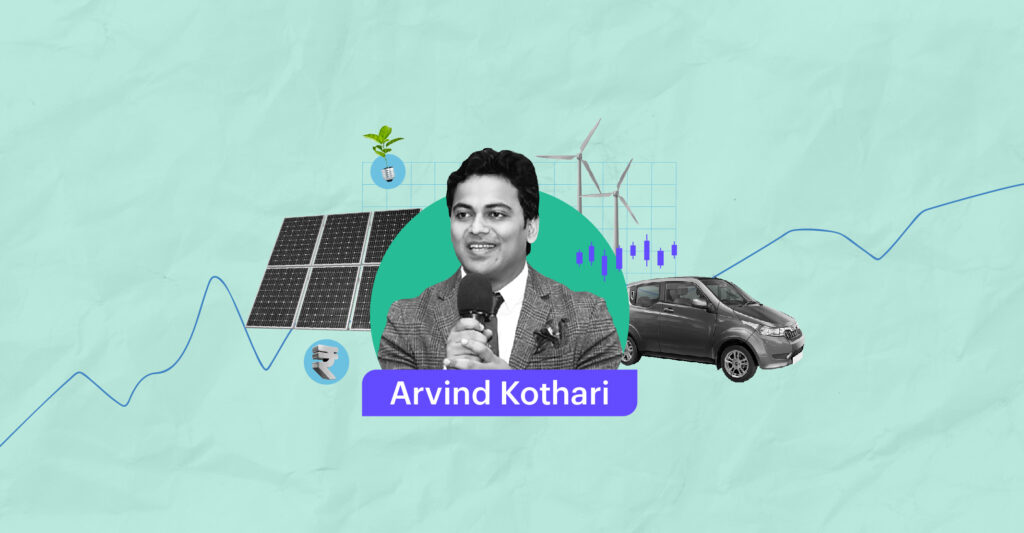Last Updated on Aug 16, 2022 by Aradhana Gotur
Arvind has been practising Equity Research and Investment Advisory for the last 12 yrs and has previously worked with ICICI Bank as an Industry Research Analyst. He then founded Niveshaay Investment Advisors, a SEBI Registered Investment Advisory Firm.
Transition to clean energy is certainly the buzzword in the global economy. Why has it suddenly become so important than ever? Well, COVID-19 accelerated the clean energy adoption trend and also made us realise that the shift to green energy is fuelled by necessity. In addition, Russia – Ukraine war also highlighted the quick shift to renewables is important. The use of renewables in place of coal will save India Rs. 54,000 cr. ($8.43 bn.) annually by 2040. Renewable energy will account for 55% of the total installed power capacity by 2030. Countries like India and Europe, who are fuel dependent on other nations, did realise the need to fill in the gaps after the energy supply disruptions for greater security after the pandemic and the war period. Hence, definitely, it’s a long term and integral play for any economy to achieve sustainable growth.
For instance, currently, we are at a very exciting point in India’s Solar Learning Curve. In the last decade, the sector has come out from disruptions, technology has matured, and this is a route to wealth creation. Moreover, the diverging cost of capital, continuous cost declines in installations and power tariff makes it a perfect decarbonisation solution.
Before we go ahead, highlighting the fact that currently, China is the major supplier globally across the value chain in the solar industry and also answering the important question:
Can India’s green energy sector be the powerhouse of investments?
We tried answering this from a manufacturing and financial investments point of view. Although the two are linked to each other but as an equity investment firm, we couldn’t resist highlighting the opportunities for the latter.
Consumption boost: India is a huge market in itself
- Solar Power Industry
India’s solar capacity in 2014 was 2.6 GW and has increased by 17x in the last 6-7 yrs, with the current capacity being around 47 GW, which is 10% of the total installed power capacity in India. The target is to reach 280-300 GW by 2030.
The current domestic solar module production is around 4 GW per annum which is expected to reach around 20 GW in 2025.
Abundant sunshine round the year also helps our country to reap the benefits of this cost-effective solution for generating power.
- Ethanol blending
Current production is at 465 cr. litres of ethanol at present. However, when the E-20 programme gets completed, the requirement will become around 1,500 cr. litres. Moreover, incoming 5 yrs, when flex engines get ready, the ethanol requirement will become 4,000 cr. litres.
According to an independent study by CEEW Centre for Energy Finance (CEEW-CEF), the EV market in India will be a $206 bn. opportunity by 2030 if India maintains steady progress to meet its ambitious 2030 target. This would require a cumulative investment of over $180 bn. in vehicle production and charging infrastructure.
For any new sector to flourish, government support to promote growth is imperative.
- PLI scheme to attract investments
Rs. 24,000 cr. have been allocated to this scheme to boost manufacturing of high-efficiency modules, prioritising fully integrating manufacturing units into solar photovoltaic (PV) modules. The government will conduct a fresh auction with a minimum 90% localisation clause. There has to be minimum integration across cells and modules.
- Imposition of 40% basic customs duty on solar modules and 25% on solar cells from 1 April 2022, promoting import substitution.
Private capex in the sector signals a green time in this sector has come
Reliance Industries has proposed to invest Rs. 5.9 lakh cr. in this space in next 10-15 yrs. RIL enters a new sector only when there is visibility of scalability and stability in terms of growth and technology, as seen in the past, too (JIO). The entry of these companies signal that the green time of this sector has come. Also, other private players like Adani, Tata Group are in expansion mode too.
When 2 + 3 happens in any sector, the multiplier effect on the growth of the sector is huge.
Small players in India, compared to China, in solar components, are expanding at a huge scale and with good profitability and margins
- Solar glass capacity expansion (borosil renewables): Current Capacity is around 450 GW which is expected to reach 1000GW in the Phase 1 expansion plan and 2100 GW in the second phase.
- EVA films: Navitas Alpha Renewables has an existing capacity of 0.6 GW and its planned capacity expansion for the next year is 0.75 GW, followed by 1.5 GW in the next 2-3 yrs. The existing domestic capacity is around 7 GW, and the proposed capex is 9.4 GW in the next 1-2 yrs. This film is used in making solar modules.
Import Substitution is playing out in solar cells, wafers and ingots through government incentives.
Another interesting thing is that Indian players are trying to become competitive globally.
For instance, the Indian companies manufacturing solar glass or EVA films used in making solar modules are able to supply their products at the same price as compared to their Chinese counterparts and at good margins. With demand picking up, companies like these can scale up their capacity easily and also tend to become a preferred global supplier, which is currently dependent on China.
Now, can India’s green energy sector be the powerhouse of financial investments?
After the pandemic, we did realise that global money is chasing this sector. In June 2020, Goldman Sachs mentioned that spending on renewable power projects would become the largest area of energy spending in 2022. In 2019, the European Investment Bank (EIB) announced that it would end financing for fossil fuel energy projects from the end of 2021. They will instead increase their support towards clean-energy projects. Similarly, many private investment banks, including Deutsche Bank, Morgan Stanely, Citi Bank, have also tightened their fossil fuels policy. Additionally, big private equity firms are now increasingly putting their investments into decarbonisation technologies.
This chart NASDAQ vs Invesco Solar ETF depicts how Solar ETFs outperformed significantly in 2020.
When we had launched the Green Energy Smallcase last year, the idea was to identify financial opportunities from the renewable energy sector, a large emerging global trend, and there wasn’t any instrument designed in India to properly play on the theme. The belief in the idea and passion for continuously exploring more opportunities in this space led us to meet some of the best entrepreneurs working in this field in our country. It was then that we stumbled upon an entrepreneur and his venture named Navitas Alpha Renewables Ltd., which resonated with our belief in the size of the opportunity and strengthened our conviction in the sector.
Also, after a decade of struggle, the returns on investment in this sector has become attractive in India. With huge expected investments, an increase in capital market activities, companies coming up with IPOs, it has become a worthwhile sector and has gained traction from investors in the last one year. The clear shift to renewables capacity is a lasting one as it is primarily driven by economics and also the advantages of this sector. The gap between the costs of new coal versus clean power generation continues to widen in favour of the latter.
Concluding the article by compelling readers to think and visualise the scope of growth for corporates, consumers and the Indian economy when the cost of power will reduce with larger adoption of green energy. After all, it’s a major cost in our day-to-day activities, making this transition important and valuable. Will this adoption transit us to a new economy? Think over it.
Happy Investing!
- Government Policy’s Role in Energy and Transportation Opportunities - Nov 6, 2023
- How To Take Advantage of Small-Cap Stocks To Make Good Profits - Apr 12, 2023
- What To Expect From Green Energy Sector in 2023? - Jan 19, 2023




